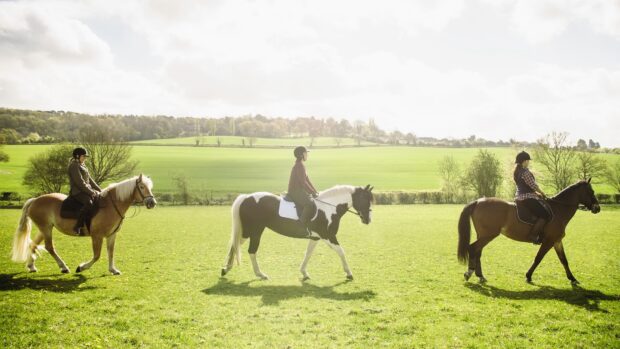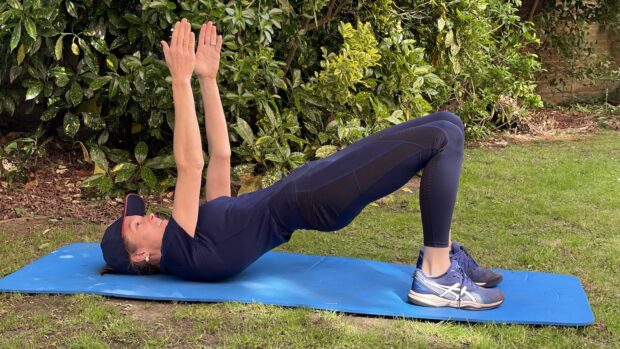Dynamic power is the focus of this fitness session with chartered physio Sarah Claridge – to hone your muscles for rising trot, the two-point canter and landing after a fence
Here are some exercises to strengthen horse riding muscles – stretching, cardio and dynamic power – to hone your muscles and target those areas riders typically need to work on.
Simply keeping fit is a good baseline, but riders have very different requirements from other athletes, from hip and spine flexibility to enable you to absorb your horse’s stride, to working the key muscles that give you stability around the hips and pelvis for lateral work.
Take care: With any new form of exercise, your body needs to build up gradually to avoid strain. Seek the advice of a chartered physiotherapist if you are unsure if you should do any exercises due to underlying health conditions. Particular caution applies if you have any cartilage injuries in your knees or joint replacements; avoid the cardiovascular exercises if you have any unstable cardiac health problems, acute disc bulges/prolapses or referred leg pain, pins and needles, numbness, rheumatoid arthritis, osteoporosis, gynaecological conditions – or if you are pregnant or undergoing cancer treatment.
Cardio exercises to strengthen horse riding muscles

Skipping
- 40 secs, 3 sets
You will need: a skipping rope
Stand upright with your feet shoulder-width apart. Hold the skipping rope handles in each hand. Extend the hands and forearms at least one foot away from the body, at a 45º angle, to create a larger arc to jump through.
Step over the rope. The rope should hang behind you and just touch the back of the feet. Use the hands and wrists to swing the rope up and over your head. Do not move the arms when swinging the rope; keep the motion limited to the wrists.
When the rope is coming around towards the front of the feet, hop over it by standing on the tiptoes, and push off with the balls of the feet. Try to keep this motion in the ankles. Maintain a fluid circular motion coordinating the wrists and feet and continue at a steady rhythmic pace.
Sarah says: “If you don’t have a skipping rope, you could even use a long lead rope or lunge line! Start with 30 seconds of skipping and a 20-second rest between sets, building up to 40 seconds skipping with a 20-second rest, doing three sets in total. Building up cardiovascular fitness is key for those riding multiple horses per day or competing.”
Stretching

W stretch
- 10 secs, 6 reps, 3 sets
You will need: an exercise mat. Don’t have one? Here are our favourites.
Adopt a sitting position with your back straight, legs out wide and knees bent.
Drop both knees to one side under control until you are in 90/90 position (both of your knees are bent at 90º). Return to the start position and repeat on the opposite side.
Sarah says: “This is a lovely opener for the hips to encourage flexibility – key for absorbing your horse’s natural strides.”
*You should not do this exercise if you have a hip replacement or excessive hip movement/hypermobility.
Dynamic power

Beginner level: step-up on to a chair
- 30 reps, 3 sets
You will need: a chair, box or step
Stand about two feet away from a chair or box. Step up on to the chair in a powerful movement, one leg at a time. Carefully step back down and repeat with the other leg leading.
Aim to keep the kneecap in line with the middle two toes on the front leg. Make sure you do not “dish” the lower leg as you step upwards.

Intermediate level: Pre-ride activation
- 14 rep, 1 set
You will need: a chair, box or step, and a 1–2kg weight
Stand up straight facing a step. Place one leg on the step and hold a weight in the hand on the same side.
Bend your elbow so the weight rests just in front of your shoulder. Ensuring your knee travels directly forwards over your toes, step up while simultaneously straightening the arm with the weight directly up towards the ceiling.
Bend your elevated leg through, bringing your knee up in front. Keep your gaze ahead and your abdominals strong throughout.
Control the movement as you lower back down to the floor, leaving the same leg on the step. Repeat this movement on the other side.

Advanced level: box jumps
- 1 rep, 1 set
You will need: a sturdy bench, box or step
Stand facing a box with your feet slightly wider than shoulder-width apart.
Keeping your chest up, squat down and immediately jump on to the box, extending through your hips. Land softly in a squat position, stand and reset to the starting position.
Sarah says: “For all of these dynamic power exercises, for your box you could use a sturdy mounting block or some bales of bedding if secured safely so as not to tip over. I’d suggest choosing the height according to your level of fitness, from 12in high up to 75in for advanced.
These three exercises use a large number of key riding muscles, such as the posterior oblique sling, which are responsible for your rising trot, two-point canter seat and anti‑gravity muscles, which are used on landing from a showjumping position. They help us to lift our wheelbarrows of muck and hay through our legs and our saddles on our horses.
Using a single leg at a time and alternating the legs aids the stability around the hip and pelvis, which is key for lateral work and aids.
Start with 30 seconds exercise, 30 seconds rest and build towards 40 seconds work, 20 seconds rest.
About Sarah: Chartered physiotherapist Sarah Claridge runs Meadow Physio and Pilates, specialising in rider strength and fitness. Visit meadowphysioandpilates.com for online classes and one-to-one sessions to help improve your body’s optimal performance. Follow Meadow Physio & Pilates on Instagram and Facebook
Exercise mats
When choosing which exercise or yoga mat to go for, there are two key elements to consider – grip and thickness.
Grip is a combination of the materials the mat is made from and the surface design, such as bumps or ridges. Polyurethane is known for providing a particularly good grip, so look out for those made of this or have a polyurethane top layer. But most mats will offer a sufficient grip for the majority of activities.
Thickness is important as a thick mat provides cushioning for your knees, elbows, hips, your tailbone and other potentially painful areas. Yoga mats usually range from 1–6mm, but general exercise mats can come thicker. You should opt for a thicker mat if you find harder floors to be uncomfortable on your knees or hips, while you should go for a thinner mat if you work out on carpet as thicker mats on carpet can make it difficult to balance.
Here are some exercise mats worth considering
Nyamba Comfort Fitness floor mat
RRP: £24.99 |
This mat is 15mm thick – thicker than your average mat – so it will offer plenty of cushioning on a hard floor.
View now at decathlon.co.uk

Sporteon TPE Eco yoga mat
RRP: £11.99 |
This anti-tear, non-slip mat is eco-friendly, antibacterial and sweatproof.
View now at amazon.co.uk

Yogamatters Eco Rise yoga mat
RRP: £45 |
Made from sustainably harvested natural tree rubber, this mat has a super grip.
View now at amazon.co.uk

Yoga-Mad Warrior Plus mat
RRP: £29.99 |
This lightweight mat is 6mm thick and suitable for all sorts of home exercise.
View now at amazon.co.uk
You might also be interested in:

Three simple exercises to get you started on your riding fitness journey

H&H’s 12 days of fitness: Improve your flexibility plus hip and pelvis control

9 things to check before you get back in the saddle as lockdown regulations ease
Before you get back on board, here are some things to consider so that you can enjoy your horse safely...

4 fitness exercises to do at home that could improve your riding

Subscribe to Horse & Hound magazine today – and enjoy unlimited website access all year round
Horse & Hound magazine, out every Thursday, is packed with all the latest news and reports, as well as interviews, specials, nostalgia, vet and training advice. Find how you can enjoy the magazine delivered to your door every week, plus options to upgrade your subscription to access our online service that brings you breaking news and reports as well as other benefits.





